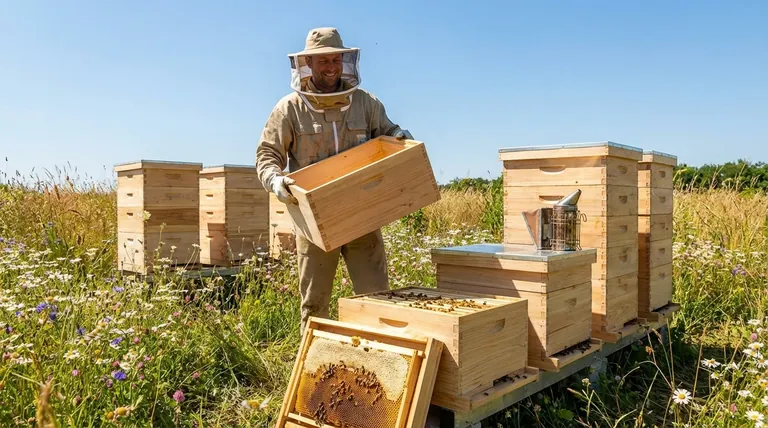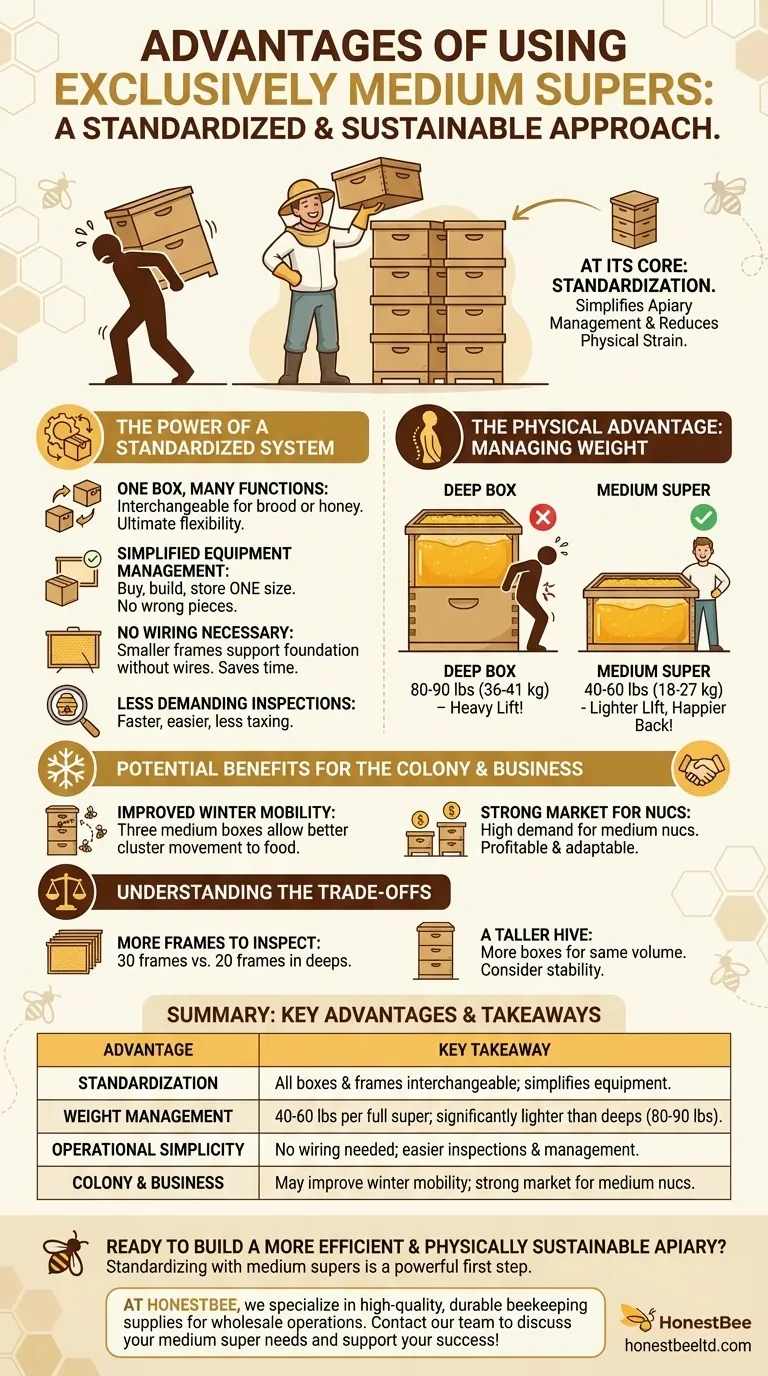At its core, the primary advantage of using medium supers exclusively is the standardization of your equipment, which simplifies nearly every aspect of apiary management. This system eliminates the need for different-sized boxes and frames, and critically, it reduces the maximum weight you will ever have to lift.
The decision to use only medium hive bodies is a strategic choice for beekeepers who prioritize operational simplicity and reduced physical strain over using the fewest number of boxes possible.

The Power of a Standardized System
Opting for an all-medium setup means that every piece of your hive, from the bottom board to the inner cover, is built around a single box and frame size. This has several powerful, compounding benefits.
One Box, Many Functions
With a single box size, every piece of equipment is interchangeable. A box used for honey collection one month can become part of the brood chamber the next, offering ultimate flexibility in hive configuration.
Simplified Equipment Management
You only need to purchase, build, and store one size of box, frame, and foundation. This dramatically simplifies inventory management and reduces the chance of grabbing the wrong piece of equipment during a hive inspection.
No Wiring Necessary
Medium frames are smaller and provide adequate support for beeswax foundation without the need for reinforcement wires. This saves a significant amount of time and effort when preparing new frames for the hive.
The Physical Advantage: Managing Weight
For many beekeepers, the physical demands of lifting heavy boxes are the biggest challenge. An all-medium system directly addresses this concern.
Lighter Lifts, Happier Back
A deep hive body full of honey can weigh 80-90 pounds (36-41 kg). In contrast, a full medium super typically weighs between 40-60 pounds (18-27 kg), making it a far more manageable lift for most people.
Less Demanding Inspections
Routine hive inspections often require lifting upper boxes to access the lower brood chamber. When each box is lighter, these inspections become faster, easier, and less physically taxing.
Potential Benefits for the Colony
Beyond the beekeeper's convenience, some arguments suggest an all-medium setup can be beneficial for the bees themselves.
Improved Winter Mobility
A standard hive often uses two deep boxes for the brood chamber. In an all-medium hive, three medium boxes are typically used instead. The extra gaps between these boxes may allow the winter cluster to move more easily between frames to access honey stores, potentially improving winter survival rates.
Strong Market for Nucs
If you plan to sell bees, there is a strong and growing market for nucleus hives (nucs) built on medium frames. Standardizing on this size can make your operation more profitable and adaptable to market demands.
Understanding the Trade-offs
While advantageous, this system is not without its considerations. The primary trade-off is the sheer number of components you will handle.
More Frames to Inspect
A hive consisting of three medium boxes for brood will contain 30 frames, compared to the 20 frames in a standard two-deep configuration. This means more frames to pull, inspect, and manage during routine checks.
A Taller Hive
To achieve the same internal volume, an all-medium hive will be taller than a standard hive using deeps. This can be a factor in windy locations or when considering hive stability.
Making the Right Choice for Your Apiary
Choosing your hive configuration is a foundational decision that should align with your physical abilities and management style.
- If your primary focus is reducing physical strain: The significantly lighter weight of medium boxes makes them the superior choice.
- If your primary focus is operational simplicity: Using a single, interchangeable size for all hive components streamlines equipment and planning.
- If you might sell bees in the future: The high demand for medium nucleus hives makes this system a strategically sound business decision.
Ultimately, selecting an all-medium system is about creating a more sustainable and physically manageable beekeeping practice for the long term.
Summary Table:
| Advantage | Key Takeaway |
|---|---|
| Standardization | All boxes and frames are interchangeable, simplifying equipment and inventory. |
| Weight Management | Full medium supers weigh 40-60 lbs, significantly lighter than deep supers (80-90 lbs). |
| Operational Simplicity | No need for wiring frames; easier hive inspections and equipment management. |
| Colony & Business Benefits | May improve winter cluster mobility; aligns with strong market demand for medium nucs. |
Ready to build a more efficient and physically sustainable apiary?
Standardizing your operation with medium supers is a powerful first step. At HONESTBEE, we specialize in supplying high-quality, durable beekeeping supplies and equipment to commercial apiaries and distributors through our wholesale-focused operations. We can provide the medium supers, frames, and other standardized equipment you need to streamline your workflow and protect your most valuable asset—your health.
Contact our wholesale team today to discuss your equipment needs and discover how HONESTBEE can support your success.
Visual Guide

Related Products
- Langstroth Honey Bee Box Hive Boxes for Different Depths
- Australian Langstroth Beehive Boxes for Beekeeping Wholesales
- HONESTBEE Professional Long Handled Hive Tool with Precision Cutting Blade
- Portable Bee Mating Hive Boxes Mini Mating Nucs 8 Frames for Queen Rearing
- Professional 500g Sectional Comb Honey Frame System for Beekeeping
People Also Ask
- What are the sizes of supers available in a standard hive? A Guide to Deep, Medium, and Shallow Boxes
- How deep is a medium bee box? Unlock the Key to a Versatile and Manageable Hive
- What factors should beekeepers consider when choosing between wooden and polystyrene hives? Maximize Bee Health and Honey Production
- What are the sizes available for Langstroth boxes? A Guide to 8-Frame vs. 10-Frame & Depths
- What is the purpose of the boxes in a Langstroth hive? A Guide to Modular Beekeeping Success



















